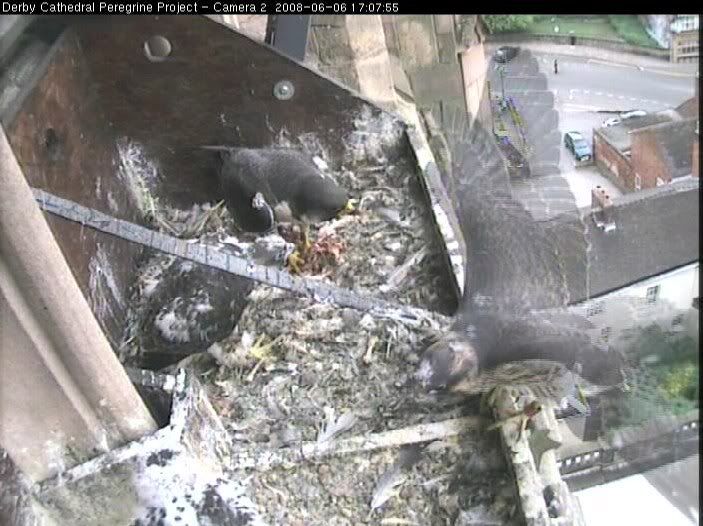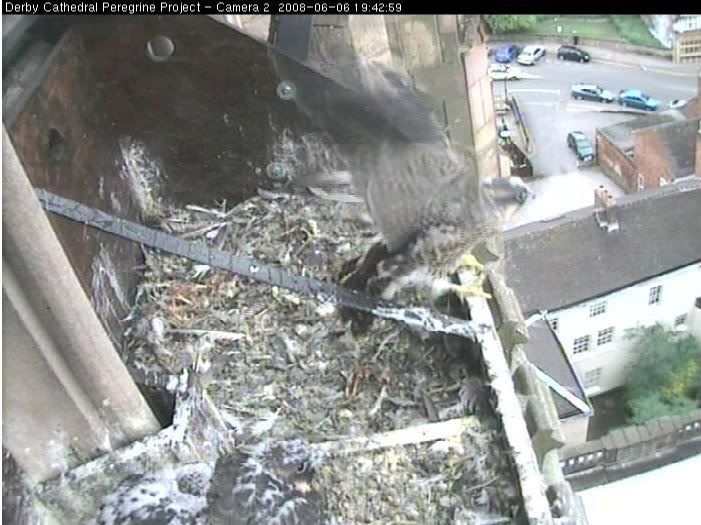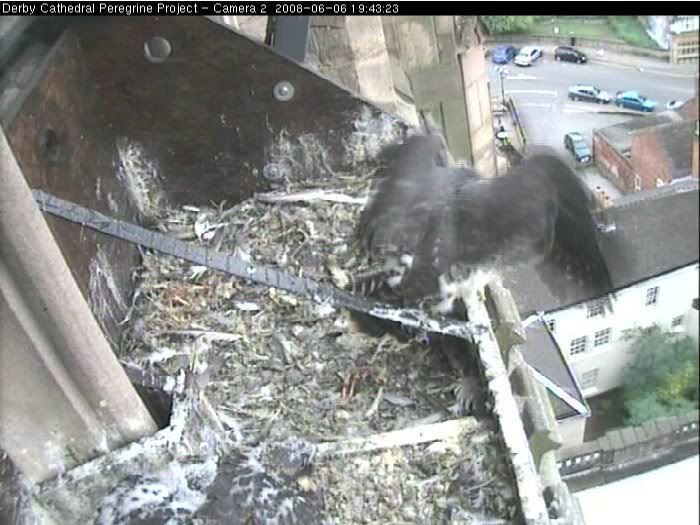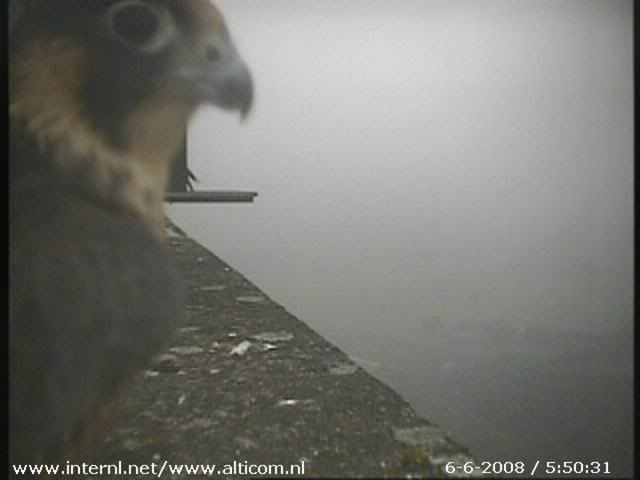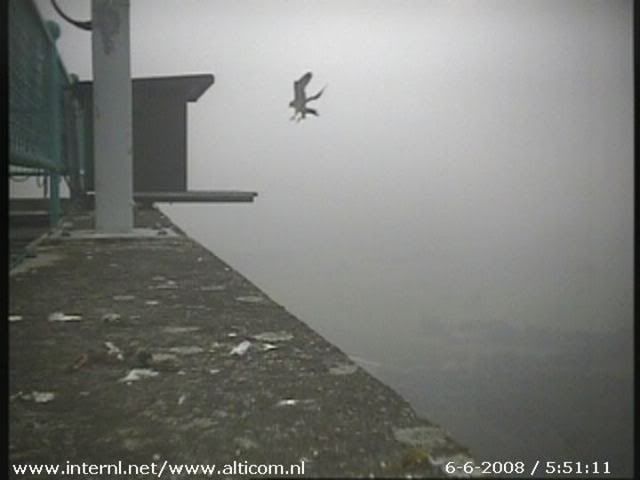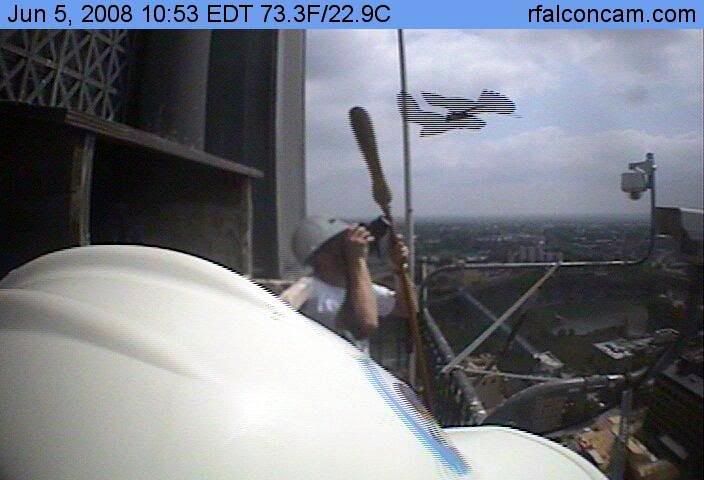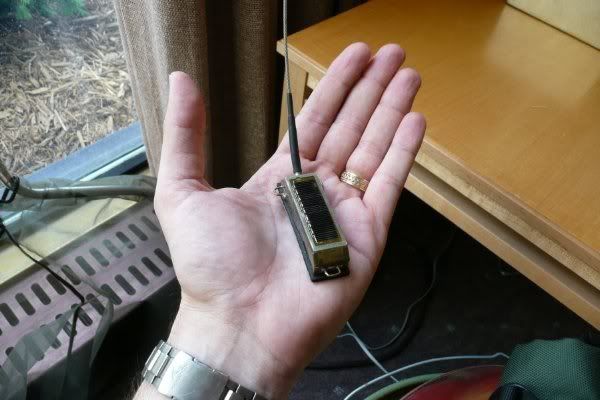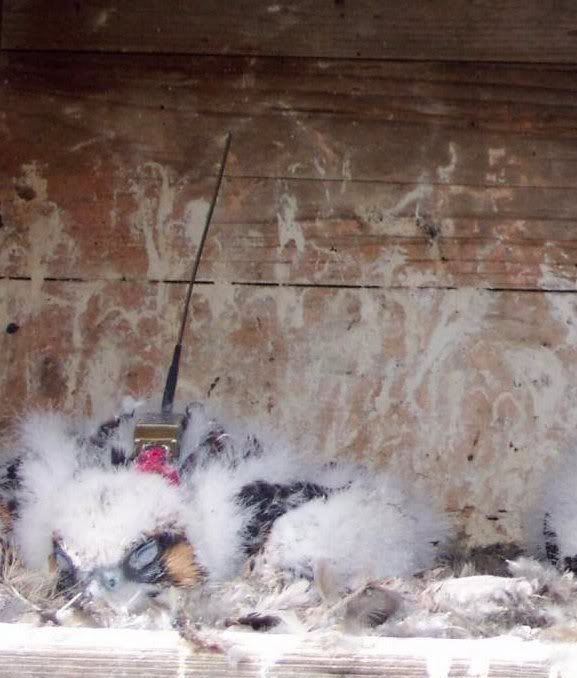

I have been reading and enjoying myself reading the Falcon Head Blog by Laura James-Reim for many weeks now. She is writing about the Indianapolis nestsite.
These are her postings on the fledge adventures of the Indy-4 of th epast 2 days and it made me smile and laugh. I can recommend all of you to read her postings on:
http://blogs.indystar.com/falconblog/Here we go:
June 5, 2008
2:05 PM UPDATE
So much for calm. Just received a call from DNR downtown. We are pretty certain there is a juvenile down on the ground at Market and Illinois by the Hilton Hotel. Two downtown volunteers are on their way over and Richard is leaving now from his place to assess the situation.
UPDATE to UPDATE: Volunteers are there - it is Adira. They were able to read the band. No rescue attempt yet but will probably happen shortly.
June 5, 2008
3:00 PM - A Happy Ending!
Okay, everyone, breath deeply. All is well. There were several volunteers to watch her while they waited for Richard to arrive and she was walking and flapping. Richard arrived, did his remarkable grab job, she did a remarkable grab job with her talons (but Richard wasn't injured), he checked her out for injuries and then headed up to the Market Tower 31st floor to put her in the gutter to start all over again.
My hunch is that this is the one who was on the south side of Market Tower, 31st floor ledge and either slipped or got blown off. The wind is very strong today. But she is okay and there is no reason to believe she won't be successful in the long run.
June 5, 2008
6:00 PM Update
We have had another flight at about 3:30. Don't know who it is, except we know it is not Adira since she was watched since she was released on 31, but the juvenile has been located on the old Federal building. There is an excellent layout of the buildings of downtown Indy on the Falcon FAQ (link at the bottom of this post) that shows where they are located if you are interested in following the birds' trails. I can say I'm not thrilled about this bird's location - we've had them there before and it usually takes a while for them to figure out where to go and what to do. It isn't a very tall building, but it is a big building with lots of nook and crannies - often hard to spot a juvie when it is stuck on the inside of the roof area.
Two are still on Market Tower behind stanchions. One juvenile at this time is on the north side of Market Tower, 31st floor ledge. We theorize this is the one that flew at 6:15 this morning. The first flyer was spotted by someone in another building across from Market Tower earlier today, along with one of the adults. Thanks Rick - much appreciated. We can surely use all the help we can get.
June 6, 2008
Falcon Escort Service
I think the word is spreading among Edna, Adira and Val. Richard's concierge service will provide fast, speedy and to your door service to the 31st floor ledge. Yes, we had another rescue today. Before you panic, everyone is okay as of when I left at 1 pm today. But Edna gave us our falcon highlight of the first half of the day.
Fairly early this morning, we had all six birds accounted for. Three juveniles were on the 31st floor ledge, two adults had been seen at various spots and in the air and we located the juvenile that had been on the Federal building at the 6:00 pm update yesterday.
First I have to give a huge kudos to Leanne, a super volunteer, who stayed downtown last night until after 9 to keep on eye on that juvenile. She last had her in sight on the rooftop of the Wellpoint building on the Circle. When she called me on my cell phone this morning to let us know where the bird was, I had just finished saying to Richard, "I hope she's not on the Wellpoint building!!" Oh, I have eaten so many words in my day and often jinxed things by saying what I don't want to occur - then it usually occurs. But the Wellpoint is not the most ideal building to be on for a juvenile falcon. It is low and there aren't too many options nearby to get higher without tremendous effort. I can't tell over the 10 years I've volunteered how many young birds I have followed on the ledge of that building, walking back and forth, back and forth while one of them is deciding how best to extricate itself from the situation, all the wailing at the world for the injustice of being down so low among us mortals. One year, we watched a bird for almost two full days walk that ledge. Argghh!!!
Anyway, the juvenile didn't wait too long to make a move. Leanne was inside Chase Tower and was able to witness it fly back to the old Federal building. I quickly made my way down there and located it right away.
To make a long story somewhat short, the bird was okay. Leanne and I were parked on the SE corner of Meridian and Ohio street, in front of Chase Tower watching it. The bird was still antsy to be on the move toward Market Tower so I wasn't sure if we were in for a very long day of antsy flapping with no action or real fly-trying. To top all the tenseness off, there was a very strong wind coming from the south that the bird would have to fly into it in order to go back toward MT. Yuck.
Thank goodness it was the real fly-trying choice for this young lady. Around 10:30 or so, she suddenly decided to take off and headed across the street toward us. She attempted to land on a small ledge about 10 or 12 stories up but didn't make it. She fell down a little, recouped and flew around in attempt to come back at the building again but at an even lower level. By then she was right over our heads and I even screamed at Leanne, "She's going to come down right on top of us!!" While I'm screaming this, I'm screaming in the radio for Richard to come down with a box because I knew she was only going one direction and that was down.
Now I know I make it out sometimes that at times there is some weird falcon thing going on with me but truly it was an amazing event today - I wish I could fully describe where the young lady eventually slid down the building and landed. It was almost literally at our feet. There are some indentations on the Chase Tower street level where floodlights are located. Somehow, the juvenile came in contact with the building right where one of those chutes was located and slid all the way down right behind us. Plop, there she was.
A small crowd started to gather as Leanne and I sort of "roped off" the area. She couldn't go backwards as the building was right behing her and we had her blocked from the front. We could easily read the band and it was Edna. She fiercely looked at us, almost as if to say "I dare you to come close." Richard soon came around the corner, box in hand, with the other volunteers and we quickly set up the rescue operation. There was a nice couple who videotaped the event with Richard's camera and I'm sure Richard will be posting it later on YouTube. I'll let you know the address when it is complete. Also, many folks had their cameras with them so I'm sure there will be some photos on the Google group later. .
She did not go down without a little fight. She dug into Richard's hands with her talons and Leanne and I had to dig them out. He finally got her wings under control, briefly checked her out and got her in the handy dandy falcon rescue box which has been useful lo these last 10 years at least.
So back up to the 31st floor ledge for Edna to be placed in the gutter to try all over again. We watched from the street to make sure no one else had a hankering for an adventure. And of course KathyQ quickly spotted the "intruders" to her kingdom and was kakking and swooping while Richard and Leanne were out there.
After that, there was not much activity. All was quiet on the eastern face of MT where the three young ladies and one young male were spending the afternoon. I thought we might see more flight from the one who flew yesterday but did not. Again, only a hunch - nothing to substantiate it - but I feel it was Magee. However, it obviously is doing okay because at some point it had to fly up to the 31st floor to join its siblings.
I can only imagine the conversation going on behind those stanchions, "Okay Val, we've both done it, now it's your turn. Really, it's kind of exciting..."
Well, I hope that isn't their "plan." I just want peace and quiet and success, young ladies!
















